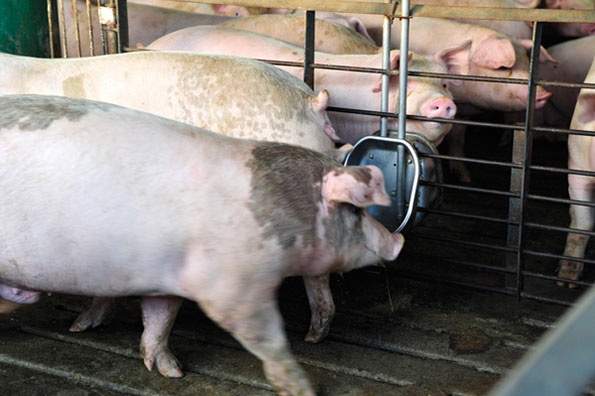Understanding differences could influence treatment protocols, allowing more defined and targeted procedures that will decrease individual pig treatment and efficacy variability.
October 2, 2018

By Heather Kittrell, Paisley Canning, Chelsea Ruston and Kristin Skoland, Iowa State University
Swine drinking habits, water wastage and the concentration of a drug in swine drinking water can affect proper dosage and administration of water medications. A recent study measured water disappearance, medication concentration within a stock solution and the daily dose received by pigs for a common swine water-soluble medication. The drug used was Tylvalosin, which is a water-soluble macrolide used to treat enteric, respiratory and arthritic pathogens.
The main objectives of the described study were:
1) measure water disappearance, stock medication bin concentration and daily dose of TVN for 60 pigs housed individually
2) determine the concentration of TVN and its metabolite, 3-O-acetyltylosin (3AT), in the synovial fluid and plasma.
These objectives allow variation to be examined in a field-based setting resembling water medication administration in a typical farm.
Water disappearance
To measure individual water disappearance, water was measured and recorded once daily for each pig for two days preceding administration of TVN. After each daily measurement and recording, the waterers were emptied and refilled with water.
The average water disappearance was 4.4 liters and had a range of 0-7.8 liters per day. TVN has a target dose of 5 milligrams per kilogram per pig, according to label directions. To measure individual dosage rates, individual pig weight, bin concentration and daily water disappearance calculations within a 24-hour period were utilized. Average daily dose per pig of TVN was 5.6 milligrams per kilogram with a range of 0-10.6 milligrams per kilogram. The wide range correlated with water disappearance: the higher the water disappearance the higher the daily dose the animal received. While water disappearance is a key measurement, it is important to note that water wastage and drinking habits were not recorded. Realizing pigs waste water, the measurements recorded during this study may be over-estimated, for both water disappearance and daily drug doses.
Stock solution concentration
TVN was administered for five consecutive days with samples and measurements collected. To produce a target concentration of 50 parts per million, TVN was dissolved into water-filled bulk mixing tanks per label directions. The solution was dispersed to individual waterers and new medication solution was provided to individual pigs every 24 hours. Water samples were collected from the bulk mixing tank at each preparation of new solution and submitted for analysis of 3AT and TVN. The average concentration of TVN across the five-day period was 59 ppm with a range of 38-75 ppm. The unexpected variability of the concentrations between water tanks could be attributed to several factors:
1) samples were collected shortly after mixing
2) only one sample was collected and analyzed per bin, per day
3) variations in drug solubility in water or
4) mixing or calculation errors.
These factors could contribute to variability of water medication preparation in a field setting and show that variability is underestimated.
TVN in the joint tissue
Assessment of the concentration of TVN and its metabolite in tissue was accomplished by collecting synovial fluid and plasma from six pigs at each of the following time points: 0, 48, 60, 72, 84, 96, 102, 108, 114 and 120 hours on medication. Joint and plasma samples for some of the animals had TVN concentrations less than 1 nanogram per milliliter, which is currently below published minimum inhibitory concentrations or the lowest concentration of an antimicrobial that will inhibit visible growth of a microorganism, such as Mycoplasma spp.
Peak concentrations that were below the MIC could be due to that the fact that TVN has a short half-life, and pig consumption was highly variable. Currently there are no published MICs for TVN’s metabolite, but it is believed to have antimicrobial activity that could contribute to clinical improvement of lameness. For most pigs, the levels of the metabolite mimicked the levels of the parent molecule.
Take home message
Due to individual animal drinking behavior, there will be variation in the medication doses within a group of pigs and variable drug concentrations in tissues. Understanding these variations, along with measurements of synovial fluid and plasma concentrations allows producers and veterinarians to improve management of water medication administration when treatment failures are perceived. Understanding these differences could influence treatment protocols, allowing more defined and targeted procedures that will decrease individual pig treatment and efficacy variability.
For producers and veterinarians on farms
This study was conducted in an environment most similar to a commercial swine farm setting to determine variability in drug dosing, water disappearance and tissue concentration. It is important to understand variation in tissue concentration between individual pigs to improve implementation of water medication on farms, troubleshoot water medication efficacy concerns and to design treatment protocols that are judicious and effective. It should be recognized that an injectable antimicrobial treatment might be required for pigs that cannot access water due to clinical lameness or other disease processes. With an understanding of water disappearance, medicated water concentrations and TVN doses, producers and veterinarians are able to make informed decisions on medication options depending on the health status of the animals requiring treatment.
Reference
Canning P, Bates J, Skoland K, et al. Variation in water disappearance, daily dose, and synovial fluid concentrations of tylvalosin and 3-O-acetyltylosin in commercial pigs during five-day water medication with tylvalosin under field conditions. J vet Pharmacol Therap. 2018; 00:1–5
You May Also Like



